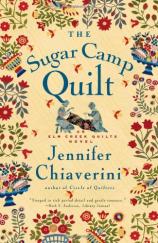The Sugar Camp Quilt
Review
The Sugar Camp Quilt
Jennifer Chiaverini adds a seventh novel to her Elm Creek Quilts
series with the story of a family's attempt to deal with the
abolition question in years immediately preceding the Civil War.
Set in Creek's Crossing, Pennsylvania in 1849, Dorothea Granger is
a temporary schoolmistress, but finds her job in jeopardy when a
wealthy man's son displaces her as teacher. Thomas Nelson rivals
her in background qualifications for the job. However, his hidden
secrets are a source of mystery she longs to unravel.
Dorothea's job loss is but one of a series of misfortunes that
threaten her family's livelihood. Business miscalculations have
stripped them of the family farm. Nearly destitute, they now reside
with an unforgiving and stern Uncle Jacob. To compound
difficulties, Dorothea has lost her hope chest in a flood, her
prized handworked quilt top gone forever. Adding insult, Uncle
Jacob demands that she make him a quilt from his exact pattern
specifications. His design is unlike any she's encountered. When
she attempts to straighten the uneven, random pattern, Jacob
insists that she re-work the stitches to his precise instruction. A
puzzlement, his reasoning is understood only upon his death.
The undercurrent in the rural community is the slavery subject.
Slaves from Southern states travel through the area on their way to
freedom, in Canada. Their route is an unspoken "Underground
Railroad" system whereby local families hide the travelers from
hunters who would re-capture, torture, and at times, kill them.
Creek's Crossing is home to sympathizers on both fronts.
Uncle Jacob, with a stiff word of thanks, takes Dorothea's finished
quilt to his sugar cabin in the woods behind the farm. Later, she
finds it slung across a chair and covered with dirt. Puzzled by
both his reverence and disregard for her quilt, she's ready to
confront him. Her hard work accomplished in dim light through long
hours means apparently little to him.
Her love of literature directs our heroine on another adventure.
With passion, she embarks on a fund-raising crusade to build a
library. The committee chairwoman is Mrs. Hiram Engle, wife of the
town's wealthy benefactor. Her son, Cyrus Pearson, has returned to
Creek's Crossing and becomes Dorothea's steady companion and escort
on committee meeting days. Her enthusiasm for the project lands her
the ominous task of putting together a quilt to be auctioned in the
fundraiser. Quilt squares will be sewn from handwriting samples
requested from favored authors, upon request by letters from the
committee. Dorothea's choices are too liberal for Mrs. Engle. A
confrontation between two strong-minded women erupts, with
embarrassing consequences for the youngest.
THE SUGAR CAMP QUILT is well-written and tells a story of life in a
rural community during times in turmoil. Neighbor is pitted against
neighbor in the stand for and against slavery. The quilting art
becomes a voice in the arguments. The villains are painted with a
full color palette. Heroes are less colorful but stand with strong
voices. This is the story of depression overcome and motives
uncovered. An understanding of quilting as an art form is an
additional bonus for the reader. THE SUGAR CAMP QUILT is without
question a good historical read.
Reviewed by Judy Gigstad on January 23, 2011
The Sugar Camp Quilt
- Publication Date: March 15, 2005
- Genres: Fiction
- Hardcover: 306 pages
- Publisher: Simon & Schuster
- ISBN-10: 0743260171
- ISBN-13: 9780743260176





